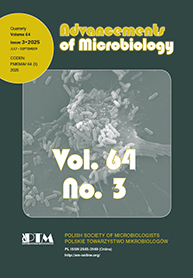Abstract: This narrative review aims to discuss the potential of phage therapy as an alternative to antibiotic therapy, with a particular emphasis on its potential applications in dentistry.
Despite historical fluctuations, phage therapy is gaining increasing acceptance and becoming more widespread in the treatment of multidrug-resistant (MDR) infections. Contemporarily, phage therapy has become a prevalent treatment modality for bacterial infections of the digestive system in countries such as Georgia. In clinical trials, it has been used to treat wounds, bone and blood infections. In theory, it can be used in any instance of bacterial infection, including within the oral cavity. There are numerous methods of administration, and the therapy itself is regarded as both safe and effective, particularly in cases where antibiotics are ineffective, such as in the development of biofilms or infections by MDR bacteria.
Despite the lack of ample clinical studies evaluating the effectiveness of this therapy in dentistry, a growing body of evidence suggests its potential use in restorative dentistry, endodontics, periodontology, as well as oral and maxillofacial surgery.
To determine whether phage therapy can be considered a viable alternative or to assess its effectiveness when used in combination with antibiotic therapy, further regulations and research are warranted.
All posts by Anna Białecka
Abstract: Periodontitis (PD) is a chronic inflammatory disease that affects a significant portion of the global population. In susceptible individuals, the disease is driven by dysbiotic microbiota on the tooth surface below the gum line, progressively eroding the tooth-supporting structures of the periodontium, including the alveolar bone. Clinically, PD manifests as attachment loss and periodontal pocket formation. Influenced by environmental factors, it can ultimately lead to tooth loss and is associated with an increased risk of systemic conditions. Host cells, including oral keratinocytes, gingival fibroblasts, and monocytes/macrophages, regulate the immune response that drives chronic inflammation and tissue damage in PD. Programmed cell death pathways – apoptosis, pyroptosis, and necroptosis – are key regulators of the immune response. These pathways orchestrate the elimination of infected, activated, and/or damaged cells, which is essential for either fuelling or resolving local inflammation. However, periodontal pathogens, particularly Porphyromonas gingivalis, can manipulate these pathways, supporting the maintenance of highly inflammatory environment. Prolonged exposition to proinflammatory agents may induce cellular senescence. This process contributes to chronic inflammation and tissue breakdown, further exacerbating the progression of PD. In this review, we discuss the key factors contributing to the onset and progression of PD, the virulence factors of P. gingivalis, and their effects on immune responses and cell death in keratinocytes, gingival fibroblasts, and macrophages.
Abstract: Protozoal infections exert significant health, community, and economic impact globally, primarily in tropical and subtropical regions. Due to the absence or inefficacy of vaccines for deadly protozoal illnesses, chemotherapy is a primary means for preventing such diseases. Growing drug resistance, rising cross-resistance, and a lack of new agents with novel modes of action all significantly reduce the effectiveness of current antiprotozoal treatments. Society seems to be ignorant of the extent and repercussions of drug resistance associated with anti-infective agents, even though it is a reality. Evidence suggests that reduced drug uptake, reshaped drug targets, genetic modifications resulting in loss of drug activity, and decreased drug export from parasites contribute to resistance development. Recently, there has been a significant gain in our understanding of drug resistance by isolating and characterizing genes and proteins associated with resistance. This fact has also paved the way for the discovery of potential new drugs. This review focuses on drug resistance in the most common vector and foodborne human-recovered parasites.
Abstract: Psychrobacter sanguinis is an emerging opportunistic pathogen predominantly isolated from cold environments that is increasingly recognized for its clinical relevance. This case report documents a rare instance of P. sanguinis bacteremia in a 69-year-old homeless patient presenting with thigh phlegmon. The patient was admitted with elevated inflammatory markers and treated empirically with antibiotics. Blood cultures identified P. phenylpyruvicus, later confirmed as P. sanguinis via 16S rRNA sequencing. Despite initial antibiotic therapy, the patient’s condition necessitated surgical intervention for phlegmon drainage. The antibiotic regimen was adjusted based on susceptibility profiles, leading to gradual clinical improvement. This case underscores the significance of accurate microbial identification in managing infections caused by less common pathogens. The severity of infection was doubtlessly influenced by the patient’s homeless status and associated risk factors, such as poor hygiene and potential environmental exposure. This report highlights the clinical implications of P. sanguinis and the importance of considering environmental pathogens in atypical presentations of bacteremia.
Abstract: The freezing and storage conditions of faecal samples in biobanks influence the preservation of the integrity and stability of genetic material and play a crucial role in scientific and clinical research quality. In recent years, there has been a particular increase in the number of studies related to the gut microbiome and the importance of its impact on the functioning human body. The review includes research on faecal microbiota transplantation (FMT), microbiome analysis, ‘-omics’ research, cancer and parasites. The primary topic addressed in this research is the impact of storage conditions and freezing methods for faecal samples on the stability and diversity of the gut microbiome. Standardizing procedures for storing and analyzing faecal samples is essential to carry out this task. This standardization is not a goal but a necessity for the quality control of the storage of faecal samples to reach comparative results and to develop new diagnostic methods. Collected data presented here highlight a crucial step in microbiota research concerning optimizing biobanking conditions for faecal samples.

